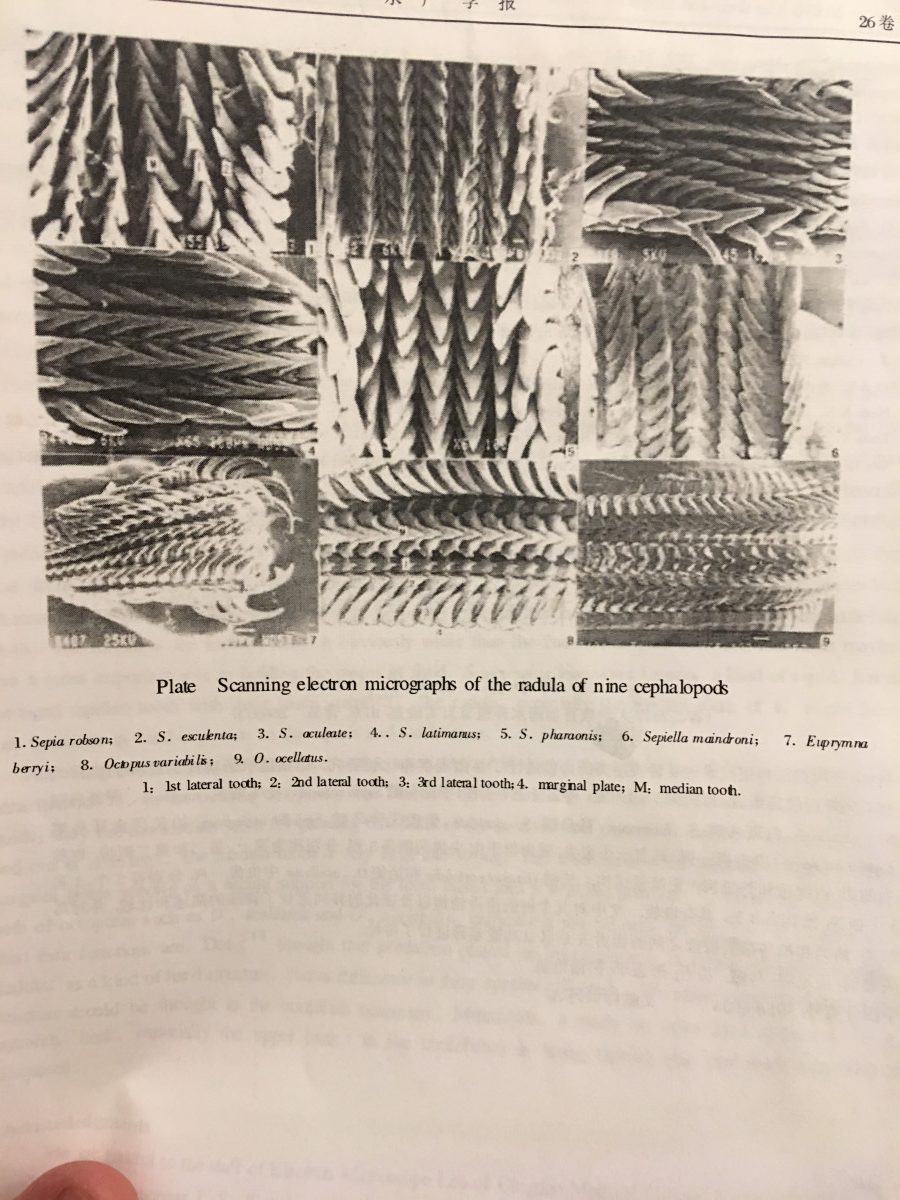
(Zheng 2012) “Morphological study on radula of nine cephalopods in the coastal waters of China”
Consistent that octopods have a heterodont radula and Sepiidae is homodont.
=====
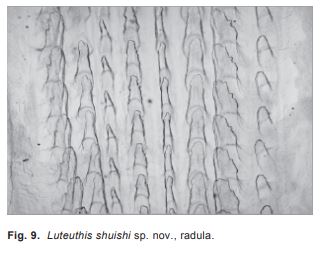
“Radula well developed, palatine teeth present or absent. […] radula present, well developed (fig. 9); ribbon long, with about 46 transverse rows of teeth; each transverse row with 8 rows of long, narrow homodont teeth; central tooth with blunt tip and irregular sides; L1 thin, long, simple, and sharply pointed; L2 thicker then central tooth, with blunt-pointed tip; M1 thicker than L2 with irregular outer side and blunt tip, right M2 with simple sides and blunt tip; left M2 missing. Palatine teeth not apparent” (120, 123).
“The only other cirrate described with a radula, Cirroteuthis macrope Berry, 1911, was referred to Vampyroteuthis infernalis Chun (Pickford 1949); no other cirrate is known that possesses either radular or palatine teeth” (125).
O’Shea, Steve, & Lu, C.C.. (2002). A New Species of Luteuthis (Mollusca: Cephalopoda: Octopoda: Cirrata) from the South China Sea. Zoological Studies, 41(2): 119-126
=====
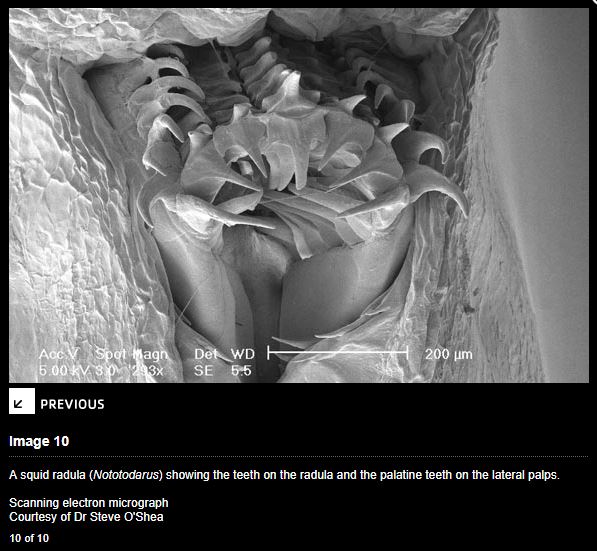
http://squid.tepapa.govt.nz/anatomy/article/the-beak-of-the-colossal-squid
=====

Fig. 11.4 Drawings of the radular row in fossil cephalopods (orthoceratid, unidentified orthocone and coleoids) and Recent Coleoidea. Abbreviations. R: rachidian tooth, L1: first lateral tooth, L2: second lateral tooth, M: marginal tooth, MP: marginal plate (first MP1, second MP2) a Michelinoceras sp., Late Silurian. Modified from Mehl (1984). b Unidentified Late Ordovician orthoconic cephalopod. Modified from Gabbot (1999). c Saundersites ilinoissensis, coleoid, Late Carboniferous. Modified from Doguzhaeva et al. (2007). d Octopus vulgaris (Octopodidae, Coleoidea). Modified from Naef (1923). e Sepia officinalis (Sepiida, Coleoidea). Modified from Naef (1923). f Loligo vulgaris (Loliginidae, Coleoidea)

Fig. 11.3 Drawings of the radular rows in Nautilidae. Abbreviations. R: rachidian tooth, L1: first lateral tooth, L2: second lateral tooth, M1: first marginal tooth, M2: second marginal tooth, MP1: first marginal plate, MP2: second marginal plate a Nautilus pompilius. b Paleocadmus herdinae, Late Carboniferous. c Paleocadmus pohli, Late Carboniferous (modified from Saunders and Richardson 1979)

Fig. 11.2 Micrographs of radulae of Recent cephalopods. a Radula of Nautilus pompilius (Nautilidae, Nautiloidea). UMUT unregistered specimen. From off Suva, Fiji. b Radula of Japetella diaphana (Octopoda, Amphitretidae). c Radula of Loligo pealei (Loliginidae, Coleoidea). d Radula of Dosidicus gigas (Humboldt squid, Ommastrephinae, Coleoidea)

Fig. 11.9 Radula of Baculites sp. (smooth) BHMNH 5496 described in Landman et al. (2007). The structure is here reinterpreted as the external mold of a row of four/five second lateral teeth (L2). a Micrograph showing the series of lateral teeth. b Sketch of the second lateral tooth (L2), the grey areas indicate the surface of the tooth that left the impression on the sediment

Kruta, Isabelle & H. Landman, Neil & Tanabe, Kazushige. (2015). Ammonoid Radula. Chapter 11: Ammonoid Radula. 485-505. 10.1007/978-94-017-9630-9_11.
======
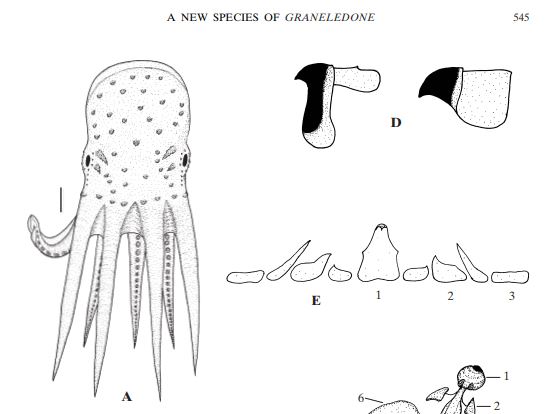
“…partly reduced homodont radula” (543).
“Radula (Fig. 1E) with tricuspid rachidian tooth, 3 lateral teeth, and one marginal plate” (544).
“Furthermore the radula structure is very different; that of Vosseledone of only a rhchidian tooth with flat plates on either side (Palacio, 1978), whereas G. yamanapossesses a radula that is simplified but has a prominent rachidian tooth, three well-differentiated lateral teeth, and one marginal plate. The bathymetric distribution of G. yamana is very wide, it is not only a deep-sea octopod as are the other members of the genus, but has also been found on the continental shelf at depths of only 90 m” (548).
*Palacio, F.J. (1978). Vosseledone charrua: a new patagonian cephalopod (Octopodidae) with notes on related genera. Bulletin of Marine Science, 28: 282-296.
Kommritz, Jurgen G. (2000) A New Species of Graneledone (Cephalopoda: Octopodidae) from the Southwest Atlantic Ocean. The Malacological Society of London 2000. J. Moll. Stud. (2000), 66, 543-549.
=====
“The radula is composed of a series of tooth rows. In Nautilus, each transverse row consists of a total of nine teeth (one central, rhachidian, and two laterals and two marginals on each side) with two pairs of marginal support plates, whereas, in most coleoids, each row is made up of seven teeth (one central, two laterals and one marginal on each side) with one pair of marginal support plates (Figure 19.6; see Nixon, 1995, for terminology). The radula is absent in the pelagic coleoid, Spirula (Kerr, 1931).
The radular teeth are secreted by a thick epithelium consisting of columnar cells (odontoblasts) that line the radular sac in the posterior portion (Raven, 1955). The posterior and central portions of the radular sac are wholly surrounded by radular muscles. In the anterior portion of the radula, the teeth are free of muscles and odontoblasts. The radular teeth of coleoids are made of a chitin-protein complex (Hunt and Nixon, 1981). Those of Nautilus also contain some amounts of calcium and silica (Fukuda, 1980)” (Tanabe, K., & Fukuda, Y. (1999) 248-249).
“Several well-preserved specimens of the orthoconic cephalopod Michelinoceras sp. (Michelinoceratidae) with remains of a radula and two long arms were described by Mehl (1984) from the Upper Silurian of Bolivia. According to his diagram, the radula consists of seven teeth in each transverse row (Figure 19.6F). though the shape and arrangement of the teeth are difficult to discern in the photographs, which are at low magnification” (251).


Chapter 19.
Tanabe, Kazushige, & Fukuda, Y., (1999). Morphology and Function of Cephalopod Buccal Mass. Functional Morphology of the Invertebrate Skeleton, Edited by E. Savaszzi. Chapter 19.
======
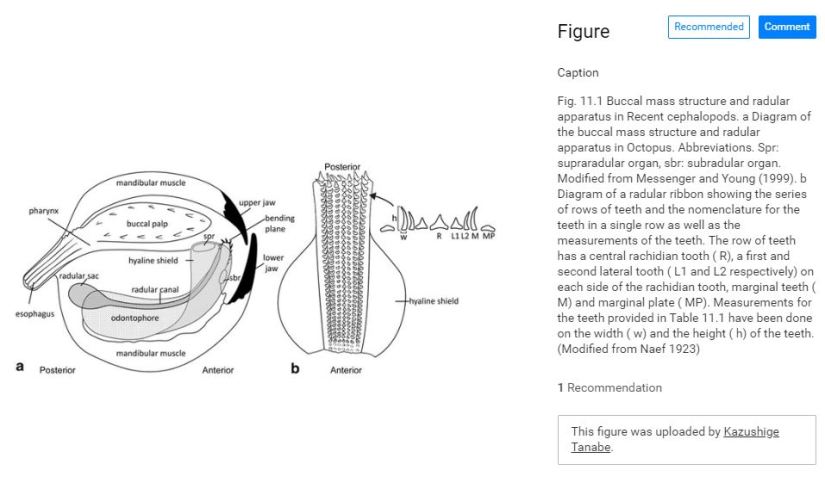
======
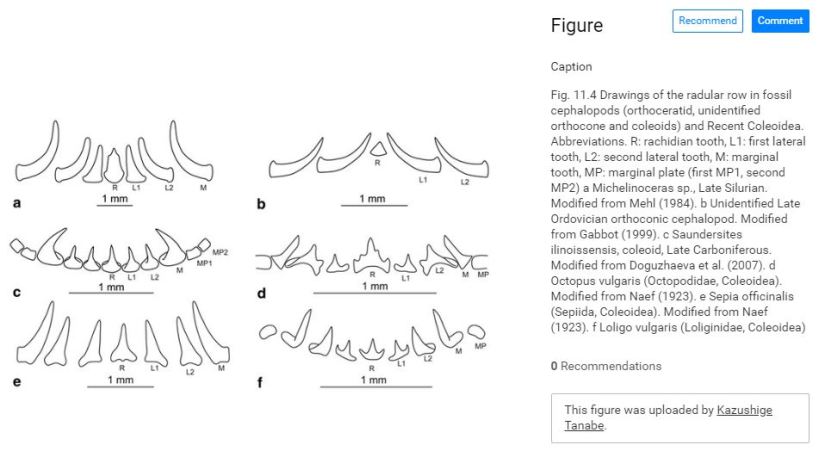
======

Attack by a cranchiid squid (probably T. borealis[heterodont]) on a deep-sea feather-star.
Okutani T., Fujiwara Y., Tsuchida S., Takehisa Y., et al. (2015) Attack by a cranchiid squid on a deep-sea feather-star. Chiribotan 45(5): 292-295.

